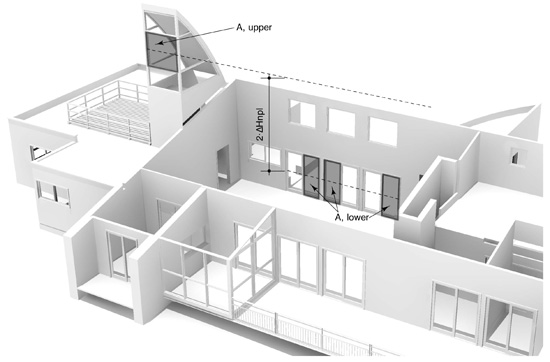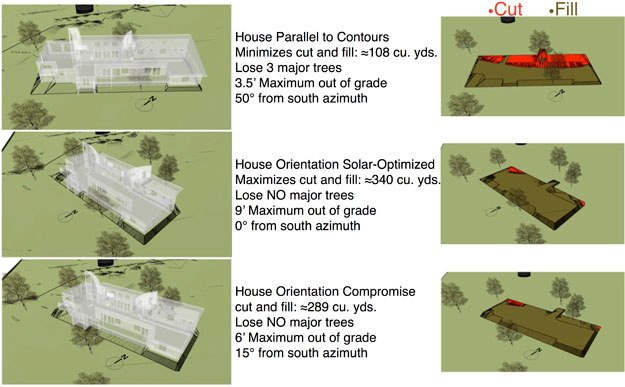Building Information Modeling as a Design Process
Designing for Sustainability and Performance
Another incredibly valuable aspect of BIM is the ability to run performance simulations of a particular building design or variation. The better the performance as determined by simulations, then the more sustainability that usually results in the final design. This is particularly true in terms of how a building can be expected to perform over its useful life, including how much energy is required to operate it. All building designs, new or renovation, are being driven to meet the challenge of reduced energy consumption and greater sustainability whether driven by large-scale environmental concerns, energy codes, or economic concerns by owners on the cost of energy. In response, designers who recognize and use this simulation capability can readily make sound decisions regarding the performance of a building in terms of things like energy usage, lighting, etc.

Image courtesy of François Lévy
A very valuable aspect of BIM is the ability to run performance simulations of a particular building design or variation, particularly for determining energy consumption comparisons. In this model, a stack-effect calculation has been integrated in BIM with a worksheet that responds dynamically to changes in aperture sizes and relative heights, automatically providing an updated airflow rate estimate.
According to the not-for-profit organization Architecture 2030, the largest impact on energy reduction comes about by the design of a building, not by adding technology. In particular, designs that acknowledge the influence of the natural site elements (sun, wind, weather, etc.) on the building's energy use patterns and use a building envelope (walls, roof, floor) to either allow or restrict those natural elements into the building can have huge impacts on energy use. BIM can play a key role in determining those impacts from the earliest design phases, as well. Simulated designs can be compared against performance standards such as the U.S. Green Building Council's LEED program, the ENERGY STAR for buildings program, or Passivhaus for residential design. Software, either within a BIM model or run separately, can account for the path of the sun, the annual weather / climate patterns, the amount of wind, and other onsite factors as they affect a building. Software can also account for the usage patterns, internal energy demands, and human factors that drive the need for energy for HVAC, lighting, or operations. Relying again on parametric design, a designer can alter a detail such as the window to wall ratio on a façade, change the orientation of a building on a site, or minimize the external surface area, and see the relative impact on energy usage each time because of that change. This information can then be used to make design decisions to optimize the building performance for energy usage while also informing other criteria for size, cost, or other factors.
François Lévy has built his Austin, Texas practice Lévy Kohlhaas Architecture around this marriage of BIM and sustainability. He describes his work as “buildings that capture the imagination, express regional beauty and a sense of place, and sit lightly on the earth.” His work investigates the intersection of design, technology, and sustainability with a particular passion about working collaboratively to create buildings that eloquently express how to use and conserve energy and water, and inhabit the land. Moreover, he asserts that “BIM offers architects a rich opportunity to validate qualitative design decisions with early quantitative analysis. When the 3D geometry and intelligence of BIM are at the service of sustainable design, architects can use green design goals as a fertile context to design buildings that are both beautiful and responsive to their climates.” Lévy's projects have attracted regional and national press, including HGTV, Dwell, This Old House, and Natural Home magazines. He has also authored a book titled BIM in Small-Scale Sustainable Design,2 which is unique in its clear procedures for designing sustainable, climate-load dominated buildings within a BIM workflow. As a resource for design professionals, the book addresses the latest technological tools in BIM, sustainable design, and integrated practice. It covers a range of topics including passive cooling and heating, building hydrology, optimizing material use, reducing construction waste, and collaboration within teams of building design professionals.

Image courtesy of François Lévy
Using BIM software tools, two competing design criteria of minimizing impact on the site while maximizing the shading effect and solar PV collection of the roof were studied in a series of simulations to determine the best sustainable performance outcome.
Lévy also advocates the leveraging of the quantitative information inherent to BIM to better inform the architect's qualitative design decisions. For example, he designed a residence on a 15-acre site in rural Texas, orienting the house on a dominant east-west axis to maximize solar gain control with a roof pitch and azimuth that are close to optimal for solar photovoltaic (PV) cells. A curved and formally expressive south-facing thermal chimney provides effective passive ventilation. The house's orientation, refined to allow all the nearby trees to thrive, coupled with a requirement of a step-less interior, was somewhat at odds with the site's topography: one end of the home was forced six feet above grade. Here, intelligent BIM software tools were used to support the architect in negotiating two competing agendas: minimizing impact on the site while maximizing the shading effect and solar PV collection of the roof. A series of simulations and BIM studies demonstrated how alternative orientations could be tested with the BIM software's intelligent site model tool and evaluated against a previously established ideal orientation from BIM solar animations. Ultimately, Lévy settled on a design that balanced site considerations and solar performance, informed by BIM's quantitative analysis capabilities.









